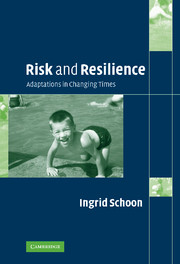Book contents
- Frontmatter
- Contents
- List of figures
- List of tables
- Foreword by Glen H. Elder, Jr
- Preface by John Bynner
- Acknowledgements
- Introduction
- 1 Risk and resilience: definitions
- 2 Towards a developmental-contextual systems model of adjustment
- 3 Persisting inequalities in times of social change
- 4 Selection, causation and cumulative risk effects
- 5 Protective factors and processes
- 6 Stability of early adjustment over time
- 7 Personal goals and life plans
- 8 Conclusions and outlook
- 9 Implications of findings for interventions and social policy
- Appendix A Two British birth cohorts
- Appendix B Response rates and handling of missing data
- Appendix C Description of variables used in the study
- References
- Index
Appendix B - Response rates and handling of missing data
Published online by Cambridge University Press: 22 September 2009
- Frontmatter
- Contents
- List of figures
- List of tables
- Foreword by Glen H. Elder, Jr
- Preface by John Bynner
- Acknowledgements
- Introduction
- 1 Risk and resilience: definitions
- 2 Towards a developmental-contextual systems model of adjustment
- 3 Persisting inequalities in times of social change
- 4 Selection, causation and cumulative risk effects
- 5 Protective factors and processes
- 6 Stability of early adjustment over time
- 7 Personal goals and life plans
- 8 Conclusions and outlook
- 9 Implications of findings for interventions and social policy
- Appendix A Two British birth cohorts
- Appendix B Response rates and handling of missing data
- Appendix C Description of variables used in the study
- References
- Index
Summary
The purpose of this appendix is to provide an account of the National Child Development Study (NCDS) and British Cohort Study (BCS70) populations and samples as they change over time, covering the major sweeps of the two cohorts until the year 2000. In the following the response rates in the two cohorts, the analytic sample and sample attrition, as well as the approaches used for handling the possible effects of missingness and non-response will be described. Another issue considered here concerns the reporting of effect sizes of observed associations.
Participation in the 1958 National Child Development Study (NCDS)
The target sample for NCDS is defined as all babies born in Great Britain during the reference week 3–9 March 1958, until they die or permanently emigrate from Great Britain. In NCDS the original target sample included altogether 17,634 babies. For the first three follow-up sweeps at ages seven, eleven and sixteen, cohort members were traced through records and the National Health Service Central Register. Throughout adulthood, tracing of the survey members was based on existing address records and was continuously updated by sending an annual birthday card.
As Table B1 shows, the overall level of response has remained high, with 10,979 cohort members taking part in the 2000 survey at forty-two. The amount of sample attrition up to the age of eleven years was quite small. Even after age eleven the attrition rate was smaller than in most panel studies (Kerckhoff, 1993; Shepherd, 1993; Shepherd, 1995).
- Type
- Chapter
- Information
- Risk and ResilienceAdaptations in Changing Times, pp. 177 - 180Publisher: Cambridge University PressPrint publication year: 2006



